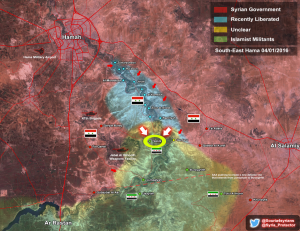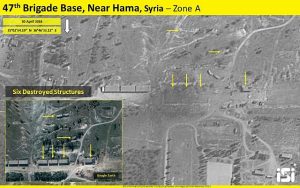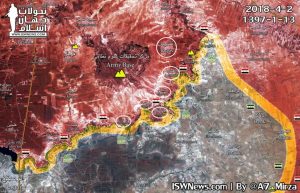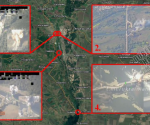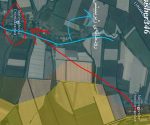Analysis: the Israeli airstrike that never was? Iran to be provoked by smoke and mirrors?
Be careful, when following events in Syria, of trusting the message because of the messenger. In the end, one doesn’t know for whom they might be working. Even if they are genuine retailers of information, for all their expertise, and their immediate presence at the theatre of war, it is possible for them to find or be given erroneous data (that anyone reusing won’t be able to judge for integrity because the ultimate source remains unknown) that then, by being many times echoed, becomes misdirection masquerading as a substantiated fact.
At the moment, there is nothing out of Syria more insubstantial than the supposed Israeli attack of 29th April. No one really seems to know for sure what happened. Yes, the Syrian Arab News Agency (SANA) itself reported that a “number of military sites in the countryside of Hama and Aleppo provinces were exposed to a new rocket attack at around 10:30 PM on Sunday”. Yes, US and Israeli corporate-media cited anonymous US officials that claimed that Israeli F-16s had struck a newly delivered consignment of air defence missiles, destroying 200 and killing 16 people, amongst them 11 Iranians. But, crucially, Israel military did not claim responsibility. Moreover, the Iranians flatly denied losing any of their own; the following from Fars:
No Iranian military advisors have been killed in the Sunday night attacks on several military bases in Syria’s Hama and Aleppo provinces, an informed source said on Monday, dismissing the claims made by few Arab media.
“No Iranian advisor has been martyred in the last night missile attacks in Hama and Aleppo provinces,” the source said.
Furthermore, Southfront cited pro-Hezbollah Lebanese TV channel Al Mayadeen, who reported comments by a commander in Liwa Fatemiyoun (an Iranian-backed group operating in Syria) that raises doubt as to the veracity of the claim that missiles had struck Iranian positions near Aleppo Airport:
According to the Liwa Fatemiyoun commander, “the military facility is not damaged, there are no casualties among the personnel.”
Other Western sources [the Telegraph for one; see link provided below] openly cite the Syrian Observatory of Human Rights (SOHR), but how would that busy lad in Coventry, being an outlet for British propaganda (let’s face it), have Iranian sources to tell him who was killed amongst their number?
It is quite noticable that on the back of these most recent attacks on Syria, some US and Israeli media have started to build up the prospect of war between Jerusalem and Tehran in Syria. It figures, then, that if there is a plan in the works to incite an Iranian reaction which would serve as a casus belli, then it would all depend on the perception of an Israeli threat – and when we bear this in mind as we consider the data, it enables us to get to the bottom of this incident.
The big problem about identifying who fired what into Syria from where (because, officially at least, it appears as if nobody knows), may have a lot to do with the fact that Syrian air defences were not deployed to engage incoming missiles. This has led commentators on the internet to speculate that the Israelis used F-35I stealth multirole fighters firing GBU-39 Small Diameter Bombs that are effective against ammo dumps and bunkers. Appearing to support this idea were images of debris circulating on the internet, that purported to show pieces of metal, still in surprisingly good shape, which might have come from the aforementioned munitions type.
A social media source, which FBEL has reported on before, and does seem to be on the ground in Syria, alighted on a different theory. Going by the handle @WaelAlRussi, this fellow has reason to believe that the Israeli jets flew through Jordanian and Iraqi airspace in order to deliver their payloads. This idea is commendable in the way it recognises the Israeli impotence from the West – something that very few observers have been able to appreciate from what should be very clear evidence.
Let’s recap: there was the incident in February where an F-16 was downed over Lebanon by Syrian air defences, and then the Israelis claimed that they had retaliated and comprehensively destroyed the Syrian capability to defend herself. This was a major lie that, for some reason, appears to have been forgotten by the entire world – even when it was exposed, with the shooting down of 71 various missiles fired in anger by the US, UK and France, as one of the biggest whoppers ever told in all history. After that disappointing flop, Mighty Israel thought it could do better than the major powers, and chimed in with its own assault on 16th April. Most of the Israeli missiles were shot down. Remarkably, the Sun newspaper reported on the debacle: “Syria’s air defence shoots down nine ‘Israeli missiles’ after fresh airstrike over Homs”, ran the headline. In all of this, we might forget that on April 8th, immediately after the Douma hoax, the Israelis staged another attack – one that also appeared to fail.
So, the notion that has become apparent to the author and others is that the skies over most of Syria are impregnable. The Twitter user, @WaelAlRussi, proposes that the Israelis, therefore, have to fly hundreds of miles out of their way to shoot through key holes, so to speak. To illustrate, he posted a map, and when one studies it, one realises how close the locations of these attacks are to the current front lines between Government forces, and the mercenary proxies for foreign powers in Hama and Aleppo. It begs the question: is it at all possible that the attacks on 29th April were actually perpetrated by ground forces?
Consider the following evidence. On the same day as the “Israeli airstrike”, members of the Arab tribes affiliated to the Syrian Arab Army, where it occupies land on the eastern side of the Euphrates, conducted a raid into four villages held by the US proxy, the Syrian Democratic Forces (SDF). They killed “Ahmad al-Jifil”, a senior Arab SDF commander, before being forced to withdraw.
This incident has been presented as an attempt to recapture territory which was repelled by the SDF, but the Syrians proved to be quite ready and able to leave without incurring headline-making casualties. If it was intended as an invasion, it certainly looks like a raid (and “quacks” like one), and if the objective was the death of an SDF commander, it could well be part of a trend of late which, due to tensions caused by ex-ISIS commanders in the SDF, involves pro-Assad groups in US-occupied Syria itself assassinating SDF leaders (the reader will have to look this up for himself). The point is, despite claims by the local SDF forces, it appears that US air support was not involved in the incident. The author awaits the latest strike report from the Combined Joint Task Force Operation Inherent Resolve†, but this raid took place less than 10 miles north west of the scene of a huge American response to a Syrian incursion in February. This time around, we didn’t hear about “AC-130 gunships, F-15s, F-22s, Army Apache helicopter gunships and Marine Corps artillery”. Are the Americans now wary of engaging with Syrian ground troops for fear of having their craft shot out of the sky? At this stage, can we be certain that there are any keyholes at all over any part of Syrian air space that the Syrian Government wants to deny to its enemy?
One of the three supposed Israeli targets was an ammo store in Hama, and one of the features of the destruction of this facility was a very large explosion that registered as a 2.6 magnitude earthquake – as measured by the European-Mediterranean Seismological Centre. It’s very interesting that this phenomenon was recorded at 7.40pm UTC, on 29th April (35 degrees north, 36.94 degrees east, 2km depth), because it was at 7.30pm UTC, or 10.30pm Syrian time, the attack was reported to have happened – see above. There is a video available to see online that purportedly shows the moment when the 47th Brigade ammo depot, east of Hama city (to give the full details), blows sky high – the Telegraph can supply the association for us:
The main target of the strike was an underground facility built into Mount Taqsis in Hama. The base is believed to be a military site where the Syrian regime developed ballistic missiles with help from North Korea. More recently, Iranian forces are alleged to have operated from the base.
The site was hit around 10.30pm on Thursday and video footage showed a vast explosion rising into the night sky as munitions exploded inside the base. The unknown person who filmed the video gasped audibly as the flames rose.
We’ll return to the errant nonsense in this article shortly. The video mentioned shows the area of the attack engulfed in flames a long time before the explosion occurs. The European-Mediterranean Seismological Centre’s timings reinforce the impression that the arms depot blew in a dramatic way because it was eventually ignited by fire after 10 minutes of burning.
Now, notice the target for the other “airstrike” in Hama: “the Fire Fighters Center in the western Hama countryside” (source). Forget Israeli stealth technology, it all starts to look very World War II, and the Guns of Navarone. If you want an arms depot to blow up, all you have to do is light a fire, prevent anyone from extinguishing it, and then wait. And actually, the Telegraph appears to be in full fantasy mode as it tries to assert the incredibly stupid North Korean ballistic missile collusion narrative, because the mountain it talks about hosts the Jabal al Bihooth (Jabal Taqsis?) weapons facility – whereas the 47th Brigade base appears to be a little bit further north (as shown in this 2016 map – click to enlarge).
Indeed, satellite images released by Israel show the 47th Brigade base as being on the surface, and not buried in a mountain like a compound owned by a James Bond villain.
To give the reader an idea how close the base is to the front lines, the village of Taqsis was liberated from the Rastan Pocket early in April, 2018, and the Rastan Pocket militants, which have rejected a reconciliation deal even this day, was still active in military opposition to the Syrian Government on 29th April.
The Times of Israel, carrying the abovementioned satellite images, claims that at least 13 buildings were destroyed in the attack on the 47th Brigade’s base. The author looked at one of these images – above – and concluded that the top horizontal arrow in the “after” image (the larger one) is not pointing at the same place as in the “before”, so one can tell immediately that the Israelis are overstating the damage and relying on dishonest representations of data. Furthermore, the Telegraph, in a flailing ejaculation of Fake News, clearly attempted to elevate the Israeli strike into literal Olympian proportions.
However, it appears quite possible, to the author at least, that unlike a donkey-jaw wielding Samson, the Israelis are entirely impotent in the sky above Syria, and the 47th Brigade base could have suffered an attack from the ground (it is a known fact that the US, UK and France have special forces operating in Syria), and certainly appears to have been burning before there was a big explosion – an explosion that could be explained by the catching fire of an arms cache. The trouble is, Iran doesn’t need to retaliate if it turns out that Israel isn’t the danger that Western and Israeli corporate-media is making it out to be. In other words, if Iran doesn’t perceive Israel to be a threat to its activity in Syria (which it rightly sees as a frontline in wider Anglo-globalist effort aimed at itself), it won’t feel pressured into lashing out and giving Israel, and more pertinently, the US, any excuse to respond either diplomatically, or militarily. And unlike corporate-media consumers, the Iranians, being on the ground in Syria, surely have their view of reality well-aligned and unaffected by Western fantasia. This might scupper a few plans in Washington and Jerusalem.
† Update, 4th May: Here is the strike report from CJTFOIR for 29th April
On April 29 in Syria, Coalition military forces conducted two strikes consisting of two engagements against Daesh targets.
One strike took place near Dayr Az Zawr.
Near Al Shadaddi, one strike engaged one Daesh tactical unit and destroyed one Daesh vehicle.
As the reader can see, CJTFOIR only makes claims about engaging ISIS (they don’t like to use the name of their moon goddess).




